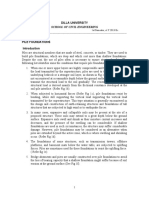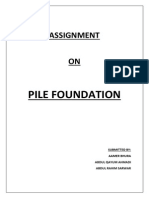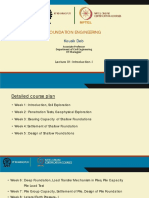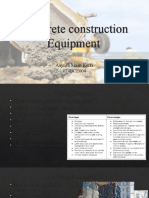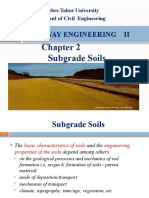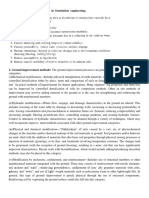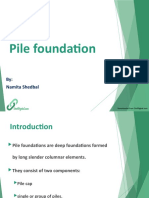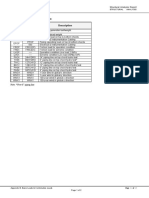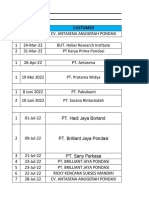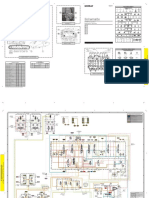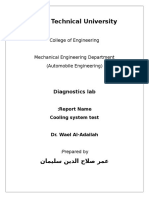12/14/2017
What is a deep Foundation?
◦ It is a type of foundation which distributes the load of
overlying structure by the toe resistance (end resistance) in a
competent soil below the structure and/or by the shaft
resistance (skin resistance) in the soil in which it is placed.
1
� 12/14/2017
When we use Deep Foundations ?
Deep foundations are used in following cases
◦ When Depth/Width ratio ≥ 4
◦ Strata of good bearing capacity is not available near the ground
◦ The space is restricted to allow for spread footing
◦ When loads from the superstructure are very heavy for which the
shallow foundations may not be feasible or economical.
◦ Differential settlement due to soil variability or nonuniform
structural load is excessive.
◦ Structural loads consist of lateral loads and/or uplift forces.
◦ In case of Bridges even if the a soil strata with good bearing capacity
is available, but the deep foundations are still required to be placed
below the scour depth.
Types of Deep Foundations
Following are the main types of
deep foundations are
◦ Piles
◦ Pier
◦ Caissons
◦ Well Foundations
◦ Sheet Piles
◦ Caissons and well foundations are
heavier in section and they are sunk
to the required depth.
2
� 12/14/2017
Caisson Foundation
Sheet Piles
Piles
◦ Piles are long, slender and vertical
members of timber, steel or
Reinforced Concrete, used as a
structural members to transfer the
load at required depth in deep
foundations.
◦ These are generally driven or cast in
situ and may be subjected to
vertical or lateral or vertical plus
lateral loads.
Classification of Piles
Piles can be classified with respect
to
◦ Mode of construction
◦ Material of construction
◦ Load transfer Mechanism
◦ Function of piles
3
� 12/14/2017
Classification W.r.t material of
Construction
◦ Precast or Driven Piles
Deep foundation elements which are pre
cast and driven in the soil up to required
depth
By driving the pile adjacent soil is
displaced, thus, classifying these piles in
certain subclasses
High volume displaced piles (displaced
volume equal to the volume of the pile)
Low volume displaced piles
No volume displaced piles
◦ Cast-in-situ or Bored Piles
These types of piles are cast in place by
drilling bore holes of required size with
the help of hollow auger.
Auger is then lift and drilled soil is
extracted.
Reinforcement is then lowered in wet
concrete or grout.
Classification W.r.t mode of
Construction
◦ Timber piles
They are tree trunks that have had
their branches and barks carefully
trimmed off.
Maximum length to most timber piles
is10-20 m.
Splicing should be avoided
◦ Concrete Piles Concrete Piling
These types of piles are obtained from
a combination of steel reinforcement
and concrete. These may be precast or
cast-in-place.
Precast piles are cast in desired length
and then transported to the site
Cast-in-place piles are built by making
a hole in the ground and then filling it
with concrete.
4
� 12/14/2017
Classification W.r.t mode of Steel Piling
Construction
◦ Steel Piles
Different structural shape or pipes of
steel are driven in the ground with
their ends open or closed to distribute
the load at a deeper level.
These piles are merged together by
welding or riveting.
Epoxy coating or concrete encasement
is done to protect them from corrosion.
◦ Composite Piles
When the piles of two different
materials are driven one over the
other, so as to enable them to act
together to perform the function.
This type of composite pile is used with
the object of achieving economy in the
cost of piling work.
Composite Piling
Classification W.r.t load transfer
mechanism
◦ End bearing pile
These piles transfer their load on to a firm
stratum located at a considerable depth
below the base of the structure and they
drive most of their bearing capacity from the
penetration resistance of the soil at the toe
of the pile.
◦ Friction piles
These piles transfer the load in the soil
through which they are driven. Their carrying
capacity is derived mainly from the adhesion
or friction of the soil in contact with the shaft
of the pile.
These are used when a hard stratum is
available at higher depth and end bearing
pile become uneconomical.
◦ Combination of end bearing and friction
piles
This is the type of pile which transfer the load
partially by end bearing and partially by
friction.
5
� 12/14/2017
Classification W.r.t function
◦ Tension or anchor piles
The type of piles which are used to provide anchorage against
horizontal pull from sheet piling wall or other pulling forces
are called Tension or anchored piles.
◦ Compaction piles
The piles which are employed for increasing the bearing
capacity of granular soils, are called compaction piles.
◦ Fender piles
Fender piles are the type of piles which protect concrete deck
or other water front structures from the abrasion or impact
caused from the ships.
◦ Batter piles
The type of piles which are driven at an inclination to resist
large horizontal and inclination forces are termed as batter
piles
◦ Sheet piles
Sheet piles are the type of piles which are used to reduce the
seepage and to provide the lateral stability.
Pile Group
◦ Piles are almost always arranged in groups of three or more.
◦ Pile group is commonly tied together by a pile cap, which is
attached to the head of individual piles and cause several
piles to act together as a pile foundation.
6
� 12/14/2017
Spacing of Piles
Negative Skin Friction
7
� 12/14/2017
Selection of Piles
Selection of type, length and capacity of pile is based on two parameters
Soil condition
Magnitude of load
Before the actual construction begins, pile load test must be made to verify
the design values and the foundation design must be revised according to
the test results.
Factors affecting selection of Piles
Following factors affect the selection of piles
Length of pile in relation to the load and type of soil
Character of structure
Availability of materials
Type of loading
Factors causing deterioration
Ease of maintenance
Estimated costs of types of piles, taking into account the initial cost, life
expectancy and cost of maintenance
Availability of funds
Pile Installation Methods
◦ The installation process and method of installations are equally
important factors as of the design process of pile foundations. In
this section we will discuss the two main types of pile installation
methods;
installation by pile hammer and
boring by mechanical auger.
◦ In order to avoid damages to the piles, during design, installation
Methods and installation equipment should be carefully selected.
◦ If installation is to be carried out using pile-hammer, then the following
factors should be taken in to consideration
The size and the weight of the pile
The driving resistance which has to be overcome to achieve the design
penetration
The available space and head room on the site
The availability of cranes and
The noise restrictions which may be in force in the locality
8
� 12/14/2017
Pile Driving Methods
Methods of pile driving can be categorized as follows:
◦ Dropping weight
◦ Explosion
◦ Vibration
◦ Jacking (restricted to micro-pilling)
◦ Jetting
Drop Hammer
◦ A hammer with approximately the weight of the pile is raised a
suitable height in a guide and released to strike the pile head. This
is a simple form of hammer used in conjunction with light frames
and test piling, where it may be uneconomical to bring a steam
boiler or compressor on to a site to drive very limited number of
piles.
◦ There are two main types of drop hammers:
Single-acting steam or compressed-air hammers
Double-acting pile hammers
9
� 12/14/2017
Pile driving using hammer
10
� 12/14/2017
Load Carrying Capacity of Piles
11
� 12/14/2017
Pile Capacities
Following are the various capacities of the piles commonly used in
practice
◦ Axial Capacity
◦ Lateral Capacity
◦ Pullout capacity or tension capacity
Estimation of Pile Capacities
The two approaches of obtaining the pile capacities are
◦ Field Approach
In this approach, the pile is loaded to the desired level and its capacity is
estimated (Pile Load Test)
◦ Theoretical Approach
In this approach, the pile capacity is calculated by using some formulae into
which soil data is fed for obtaining the capacity. (Empirical Method, (Static
and dynamic formulae))
Pile Load Test
◦ This test is used to determine the “ Load Carrying capacity” of a pile.
◦ This test gives us the value of
Ultimate load value
Safe load value
Settlement under different values of loads
Procedure
12
� 12/14/2017
Procedure (Contd…)
Geotechnical Design of Piles
13
� 12/14/2017
Calculation of Capacity (Static Formula)
◦ Calculation of Qs
14
� 12/14/2017
Useful Factors
Useful Factors
15
� 12/14/2017
Useful Factors
Calculation of Capacity (Static Formula)
◦ Calculation of Qb
16
� 12/14/2017
Calculation of Capacity (Static Formula)
◦ Calculation of Qb
Solved Examples
◦ Example 1:
17
� 12/14/2017
Solved Examples
Solved Examples
◦ Example 2:
18
� 12/14/2017
Solved Examples
◦ Example 2:
19
� 12/14/2017
Home Work
◦ Example 1:
Home Work
◦ Example 2:
20
� 12/14/2017
Other Types of Deep Foundations
◦ Caissons
Caissons are water light structures made up of wood, steel or
reinforced concrete, constructed in connection with excavation
for foundations of bridges, piers, abutments in river and lake
dock structure fore shore protection etc.
The caisson remains in its pose and ultimately becomes as
integral parts of the permanent structure.
Caisson can be broadly classified into the following three
types:
Open Caisson
Box Caisson (Floating Caisson)
Pneumatic Caisson
Uses of Caissons
21
� 12/14/2017
Well Foundations
Piers
◦ The main supports for a bridge upon which the bridge rests are called Piers
22
� 12/14/2017
Sheet Piles
◦ Sheet piles are the type of piles which are used to reduce the seepage
and to provide the lateral stability. They are used for the following
purposes.
23



